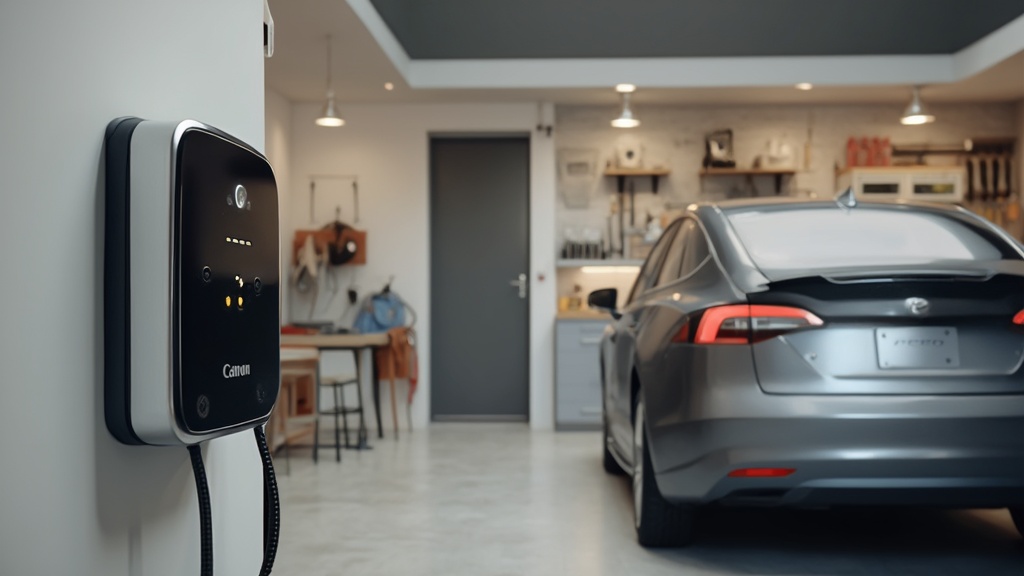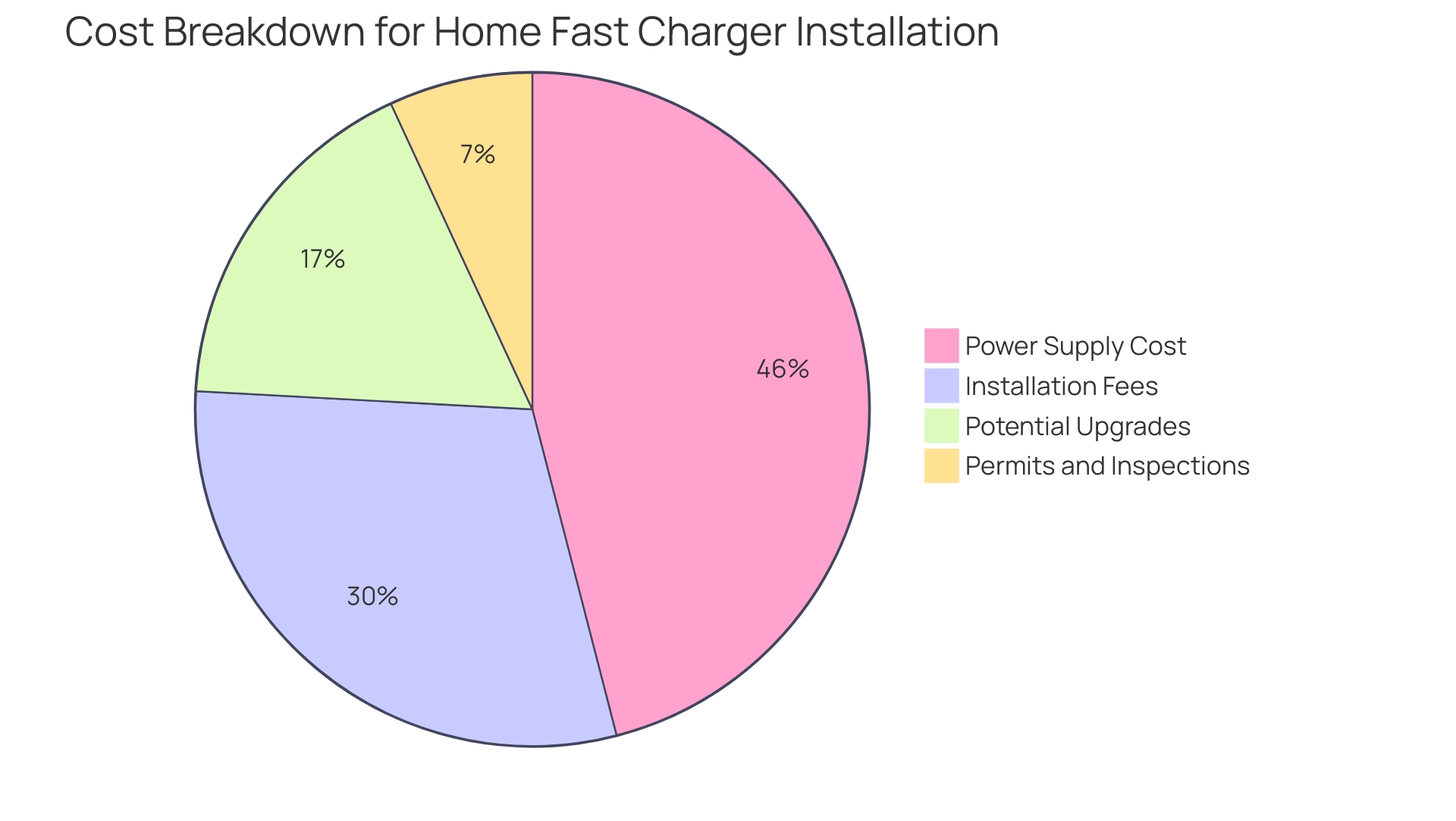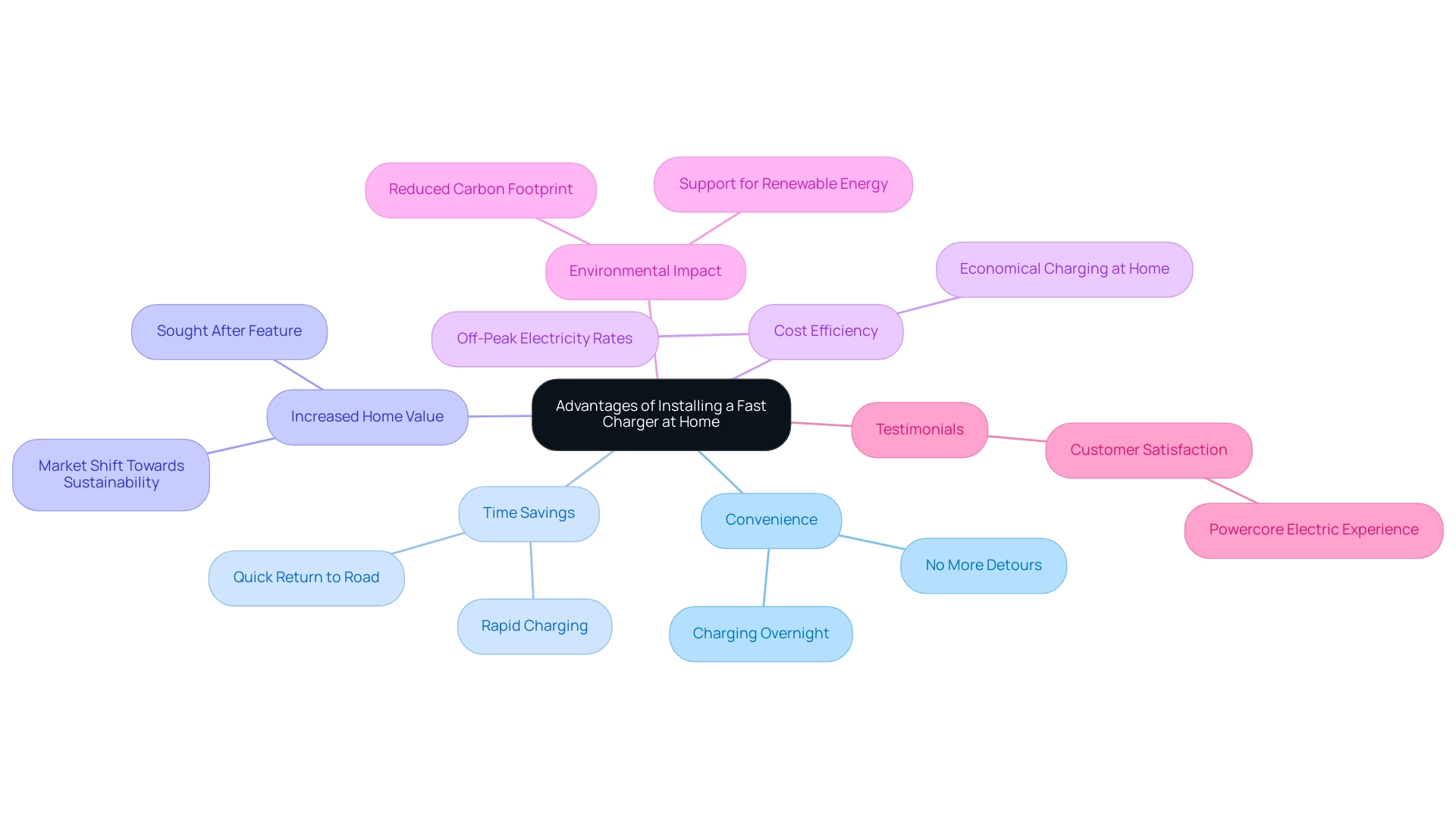Overview
The article provides a comprehensive step-by-step guide on how to install a fast charger at home for electric vehicles (EVs), emphasizing convenience, efficiency, and the environmental benefits of such installations. It supports this by detailing necessary preparations, costs associated with installation, and the advantages of having a fast charger, including time savings and increased home value, thus making a strong case for homeowners considering this upgrade.
Introduction
As electric vehicles (EVs) continue to gain traction, the importance of efficient charging solutions has never been more pronounced. Fast charging technology is revolutionizing the way homeowners power their EVs, offering a convenient alternative to public charging stations.
With options ranging from Level 2 chargers that can rejuvenate a battery overnight to high-speed DC fast chargers ideal for long journeys, understanding these technologies is essential for anyone looking to enhance their home’s energy efficiency.
This article delves into the various types of fast chargers, the installation process, and the myriad benefits of having a fast charger at home, all while highlighting the exciting advancements in EV infrastructure that make this a timely and worthwhile investment.
Whether it’s about maximizing convenience or contributing to a greener future, homeowners will find valuable insights to navigate their charging options with confidence.
Understanding Fast Charging: Types and Benefits
Rapid energy replenishment technology has genuinely changed the manner in which we install fast chargers at home for our electric vehicles (EVs), making it more convenient than ever. Powercore Electric Inc. provides comprehensive solutions, including various EV refueling stations and advanced battery backups, to complement your sustainable energy needs. Our Level 2 stations, commonly found in many households, function at 240 volts and, when you install a fast charger at home, can generally replenish most EVs in only a few hours—ideal for overnight use or when you have some time available.
For those instances when you require a rapid increase in power, we also offer DC fast units, tailored for extended journeys, which can greatly reduce power-up durations; however, to benefit from this convenience, you may need to install a fast charger at home, and it comes with a higher cost.
Comprehending these alternatives is essential for homeowners aiming to enhance convenience and efficiency while minimizing dependence on public power sources, particularly if they choose to install a fast charger at home. As we look forward, it’s thrilling to observe initiatives like Australia’s EV Installation Initiative, where the government is investing AUD 39.3 million to set up stations along highways every 150 km. Additionally, Sweden plans to open a permanently electrified road by 2025, with up to 3,000 km of further road expansion by 2045, showcasing significant advancements in EV infrastructure.
This type of infrastructure improvement highlights the increasing dedication to electrification, with numerous automobile manufacturers participating in the movement through initiatives like EV100.
Furthermore, private investment in medium- and heavy-duty vehicle power supply infrastructure in the US reached USD 4.2 billion by the end of 2023, underscoring the financial commitment to EV power solutions. By 2028, experts from the IEA predict we could see around 1,000 EV models available, making the choice of the right charger all the more important. With the rise in fast charging technology adoption expected in 2024, homeowners can feel confident that if they install a fast charger at home, they are making a smart investment in their sustainable future.
For more information on our services, including our range of solar panels and battery backups tailored to your energy needs, please contact Powercore Electric Inc. at ryan.serrano@powercoreinc.net or call us at (916) 699-8778. We are here to help you make the best choice for your home and the environment.
Step-by-Step Guide to Installing a Fast Charger at Home
- Gather Necessary Tools and Materials: To kick things off, make sure you have all the essentials at hand. You’ll need your rapid power supply, some sturdy mounting hardware, electrical conduit, a drill, screwdrivers, and of course, safety gear to keep you protected throughout the process.
- Choose the Installation Location: Next up, pick a spot that’s convenient for you! Ideally, it should be close to your electrical panel and parking area, taking accessibility and safety into account. A good location can make all the difference when it comes to charging your vehicle efficiently. Remember, most Level 2 devices come with 25-foot cables, giving you plenty of flexibility in choosing the right spot!
- Turn Off Power: Safety first! Before you start any electrical work, switch off the power at the main circuit breaker. This step is crucial to ensure you’re working in a safe environment.
- Mount the Device: Now it’s time to get your power supply up on the wall. Use the mounting hardware to securely attach it at a comfortable height for easy access.
- Run Electrical Wiring: Connect your device to the electrical panel, ensuring you follow local codes. It’s a good idea to consult with a licensed electrician for this part, as they can help ensure everything is up to standard and safe.
- Connect the Device: Following the manufacturer’s instructions, carefully connect the device to the power source. An expert from Enel X Way points out that their 48-amp charging station can be adjusted to accommodate circuits from 20 to 60 amps via their app, offering flexibility in setup.
- Test the Installation: Once everything is securely connected, turn the power back on and test your device to ensure it’s functioning correctly. It’s always satisfying to see your hard work pay off!
- Finalize Setup: Lastly, complete any outstanding setup procedures according to the manufacturer’s guidelines, and then you’re all set to enjoy your new fast device! With the right setup, you can charge your vehicle five to seven times quicker than with standard Level 1 options, making your life much easier. Furthermore, numerous governments provide incentives for setting up EV stations at residences, so consult your local authorities for accessible programs that can assist in reducing setup expenses.
- Consider Solar Battery Integration: As you optimize your energy solutions, think about enhancing your eco-friendly setup with solar batteries. When selecting a solar battery, consider critical factors such as capacity (measured in kilowatt-hours), lifespan (typically 5-15 years), efficiency (how much energy is usable), and cost. Understanding these aspects will help you choose a battery that complements your EV charging needs. Powercore Electric Inc. provides different solar options, including the setup of Tesla residential power units and battery backups, ensuring you have a thorough strategy for energy efficiency in your residence. Furthermore, inquire about government incentives available for solar battery installations, as these can significantly reduce your overall investment.
Preparing for Installation: Key Considerations and Requirements
Before you embark on the exciting journey of installing your EV power system, it’s essential to consider several key factors to ensure a smooth and safe setup:
- Electrical Capacity: Your home’s electrical system must accommodate the additional load that comes with a fast charger. Consulting an electrician is a wise first step; they can assess your current capacity and recommend any necessary upgrades. Many homeowners might not realize that the cumulative private investment in charging infrastructure, particularly for medium- and heavy-duty vehicles, has reached an impressive USD 4.2 billion in the United States by the end of 2023, showcasing the growing importance of EV infrastructure in our society.
- Local Codes and Permits: Familiarizing yourself with local regulations is crucial. Many jurisdictions require permits for electrical setups, and ignoring this can lead to complications down the line. Your local building department can offer advice on the specific permits required for residential setups. As part of the broader EV infrastructure development, companies like Milence are planning to build 1,700 public power supply points across Europe by 2027, emphasizing the need for compliance with local regulations.
- Charger Location: Selecting a convenient spot for your power source is vital. Ideally, it should be easily accessible for your vehicle and located near your electrical panel to minimize wiring costs and complications.
- Safety Measures: Ensure the installation area is free from obstructions and has sufficient ventilation. These precautions not only improve safety but also assist in preserving the longevity of your power equipment. The advancements in Electric Road Systems (ERS), which enable vehicles to replenish power while driving, illustrate the evolving landscape of EV energy solutions. Countries such as Sweden are intending to electrify highways by 2025, signaling a move toward creative charging techniques.
By tackling these factors from the beginning, you’ll be well on your way to a successful setup, ensuring that installing a fast charger at home makes your shift to an electric vehicle both efficient and enjoyable. If you require assistance, Powercore Electric Inc. provides extensive electrical setup services, including estimates and safety inspections, to support you throughout the process. We also specialize in solar panels and battery backups, ensuring you have a complete energy solution for your residence.
Reach out to us today for a complimentary estimate on your EV charging setup, and let’s make your EV charging experience seamless!
Cost Analysis: Budgeting for Your Home Fast Charger
When planning your budget to install a fast charger at home, it’s essential to keep a few key costs in mind to ensure a smooth installation process and avoid any surprises. Here’s a breakdown of what to consider:
- Power Supply Cost: Fast power supplies can set you back between $500 and $1,500, depending on the brand and features that best suit your needs. Some power adapters offer advanced options that might be worth the investment based on your usage.
- Installation Fees: Hiring a licensed electrician is crucial for a safe setup, and this can cost anywhere from $300 to $1,000. The final fee largely depends on the complexity of the installation and the specific requirements of your home.
- Permits and Inspections: Don’t forget about local regulations! Permits may range from $50 to $200, and depending on where you live, inspections can add to the overall cost.
- Potential Upgrades: If your electrical system requires enhancements to support the new device, this could add a few hundred dollars to your budget. It’s wise to have an electrician assess your current setup to avoid surprises.
In addition to these costs, consider the U.S. average cost for residential electricity, which is 16.83 cents per kWh. This figure can offer a clearer financial context when planning for residential power supply. Moreover, the state-by-state analysis of electricity expenses for EV use emphasizes how regional electricity prices can greatly affect total expenses, making the budgeting process more relevant and based on real-world information.
Overall, planning for how to install a fast charger at home can differ greatly due to these factors, but understanding them will assist you in organizing effectively. This way, you can enjoy the benefits of electric vehicle charging at your residence without unexpected expenses creeping in. With gasoline costs averaging almost $4.60 per gallon in Hawaii, investing in a residential charging station can also result in considerable savings over time, aligning your eco-conscious decisions with your financial objectives.
As Eric Brandt points out, understanding the financial implications of purchasing and installing an EV charging station is crucial for making informed decisions.
The Advantages of Installing a Fast Charger at Home
Installing a fast charger at home provides numerous benefits that can improve your daily life and positively affect the environment. Here’s why you should consider it:
- Convenience: Imagine charging your electric vehicle (EV) overnight and waking up to a full battery, ready to go. This means no more detours to public power stations, simplifying your routine. At Powercore Electric, we ensure your installation is tailored to fit your home, leveraging our local expertise to meet the unique energy needs of California communities.
- Time Savings: Rapid devices can drastically cut down your charging time. Whether you’re replenishing your battery during the day or preparing for a road trip, these devices allow you to return to the road swiftly. Our dedication to unparalleled quality craftsmanship ensures that your device is installed safely and efficiently, providing you peace of mind.
- Increased Home Value: Homes fitted with rapid charging stations are becoming more sought after. As the market shifts towards sustainability, having a fast charging device can make your property stand out to potential buyers looking for eco-friendly options. In fact, the number of publicly accessible chargers in Europe increased by 30% in 2021, reflecting a growing infrastructure supporting EVs. With Powercore Electric, you can trust that your residence is equipped with the best.
- Cost Efficiency: Powering your vehicle at residence is often more economical than depending on public stations, especially if you take advantage of off-peak electricity rates. As Asensio pointed out, “Individuals are becoming exasperated because they don’t feel like they’re receiving their money’s worth” when utilizing public alternatives, highlighting the importance of residential power supply. Our personalized service guarantees you discover the most cost-effective power solutions tailored to your needs.
- Environmental Impact: By choosing renewable energy sources to charge your EV, you’re not only reducing your carbon footprint but also contributing positively to a more sustainable future. Furthermore, advancements in Electric Road Systems (ERS) are paving the way for innovative power solutions, indicating a significant shift towards sustainable freight transport that enhances residential power benefits.
- Testimonials: “Powercore Electric transformed my charging experience! The installation was seamless, and I love knowing I’m contributing to a greener planet,” says a satisfied customer. This is just one of many testimonials from clients who appreciate our commitment to quality and sustainability.
Considering these benefits, the decision to install a fast charger at home is not just practical; it’s a worthwhile investment in convenience and sustainability that can elevate your home’s appeal. Ready to make the switch? Contact Powercore Electric today for a personalized estimate, and let us help you embrace a cleaner, more sustainable future!
Conclusion
Embracing fast charging technology for electric vehicles at home opens up a world of convenience and efficiency for homeowners. From understanding the different types of chargers available—like Level 2 and DC fast chargers—to navigating the installation process, this journey is about making informed choices that enhance daily life and contribute to a greener future.
The benefits of having a fast charger are substantial. Homeowners can enjoy the luxury of charging their vehicles overnight, saving time and eliminating the need for public charging stations. As EV infrastructure continues to expand, the investment in home charging solutions not only increases property value but also aligns with sustainable living practices. Moreover, by leveraging renewable energy options, individuals can significantly reduce their carbon footprint while enjoying cost savings on energy.
As the electric vehicle market evolves, so too does the importance of staying ahead with the right charging solutions. By considering the various factors involved—from installation costs and electrical capacity to local regulations—homeowners can confidently embark on this transition. With the right information and support, the journey toward efficient and eco-friendly charging can be both seamless and rewarding.




